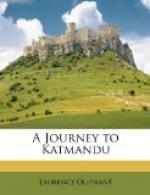The stream was rapid, and carried the boats down some distance. Ten elephants, with nothing visible but the tips of their trunks and the crowns of their heads, on which latter squatted the mahouts, made the passage gallantly. On the opposite side we passed through a village, the little square of which was absolutely filled with monkeys. They resort thither by hundreds from the neighbouring jungles to be fed by the villagers, and are most independent in their behaviour, unscrupulously attacking the man who brings their daily allowance, and, as they are accounted sacred, they are of course unmolested. We saw some serious fights amongst them, young and old mixing indiscriminately in the melee; a mother was frequently seen making a rapid but orderly retreat with her young one on her back.
We occasionally passed picturesque villages, the inhabitants of which were of course all attracted by so novel a spectacle. The system pursued by the villagers here is the same as may be observed in many parts of the Continent of Europe: they invariably congregate in a collection of mud-built closely packed huts, showing a gregarious disposition, and great aversion to living alone. I do not remember to have passed one solitary house. As the whole of the country is richly cultivated, the distance of their dwellings from the scene of their daily labour must in some instances be considerable.
The Gandaki, over which we were ferried, is a large stream rising in Nepaul, and as broad as the Gograh. We went some distance up its banks, in the hopes of finding wild-pig, but were unsuccessful.
The minister, however, being determined not to go home empty handed, doomed to destruction a huge alligator, unconsciously basking on a sand-bank. Accordingly, arming eight of us with double-barrelled rifles, he marched us in an orderly manner to the bank, when, at a given signal, 16 balls whistled through the air, arousing in a most unpleasant manner the monster from his mid-day slumbers, who plunged into the stream and disappeared almost instantaneously, and the Minister Sahib, coolly pulling out the wallet which contained his tiffin, remarked that we might profitably employ ourselves in that way until he came up to breathe, when he should receive another dose. Retiring therefore a few yards from me—for a Hindoo may not eat in the presence of a Christian—he and his brothers were soon deep in the mysteries of curious viands. Perceiving, however, that I was not prepared for an alfresco luncheon, he shared with me some grapes, pomegranates, etc., as well as a piece of green-looking meat, which I found very delightfully scented. As we were in the middle of our repast, our wounded friend showed his nose above the water, when he was immediately struck by a splendid shot from the minister, who was in no way disconcerted by having his mouth full at the time. Lashing the water furiously with his tail, the alligator once more disappeared: he came up shortly after, and the same scene was enacted three times before his huge form floated lifeless down the stream.




